Abstract
The nematode Caenorhabditis elegans produces four distinct myosin heavy chain (MHC) isoforms, A, B, C, and D. The MHC A and MHC B proteins are coordinately expressed in the body wall muscle and are incorporated into different regions of a single kind of thick filament. MHC C and MHC D are exclusively produced in the pharyngeal muscle. Previous studies of mutations that affect MHC B have shown that this isoform is encoded by the unc-54 gene. Three other MHC genes, myo-1, myo-2, and myo-3, were isolated from a C. elegans genomic library by hybridization with fragments of the unc-54 gene. We have now established the MHC isoform encoded by each gene. Restriction fragments from each of these genes were cloned in the plasmid expression vector pUR288, producing fusion proteins between Escherichia coli beta-galactosidase and portions of the MHC rod domains of each gene. The hybrid proteins were screened with a panel of 18 isoform-specific monoclonal antibodies. The results demonstrate that myo-1 encodes MHC D, myo-2 encodes MHC C, and myo-3 encodes MHC A.
Full text
PDF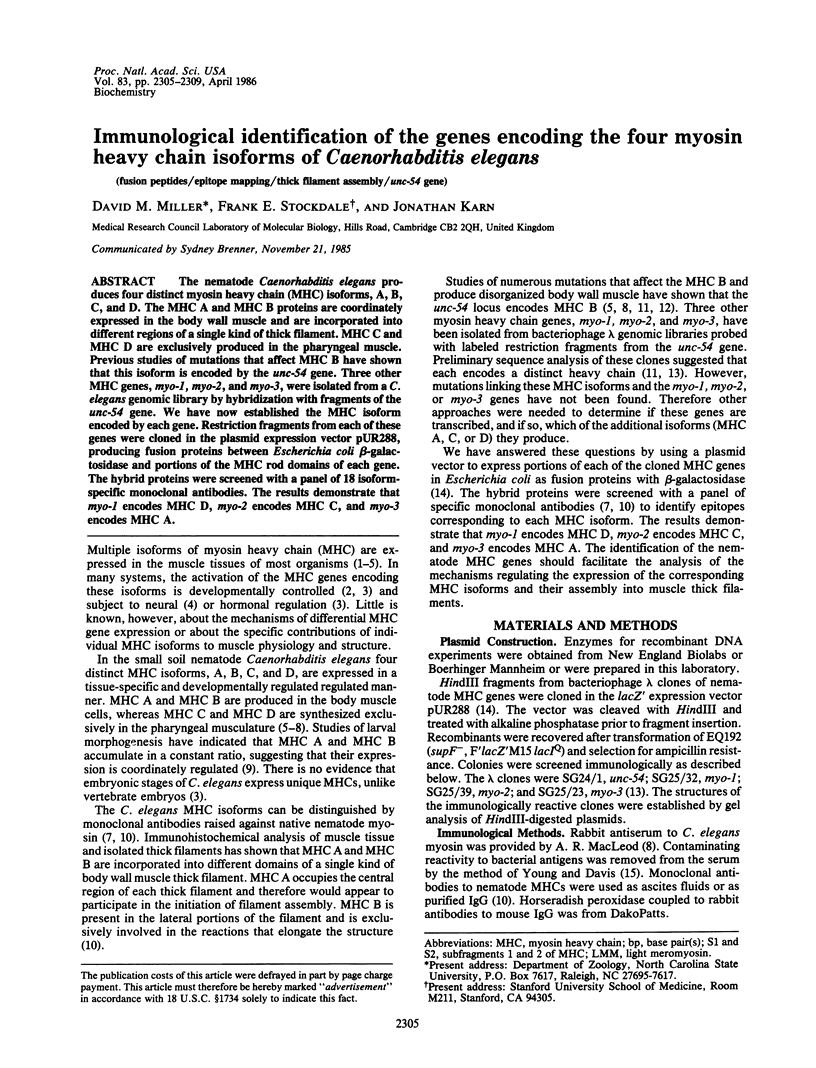
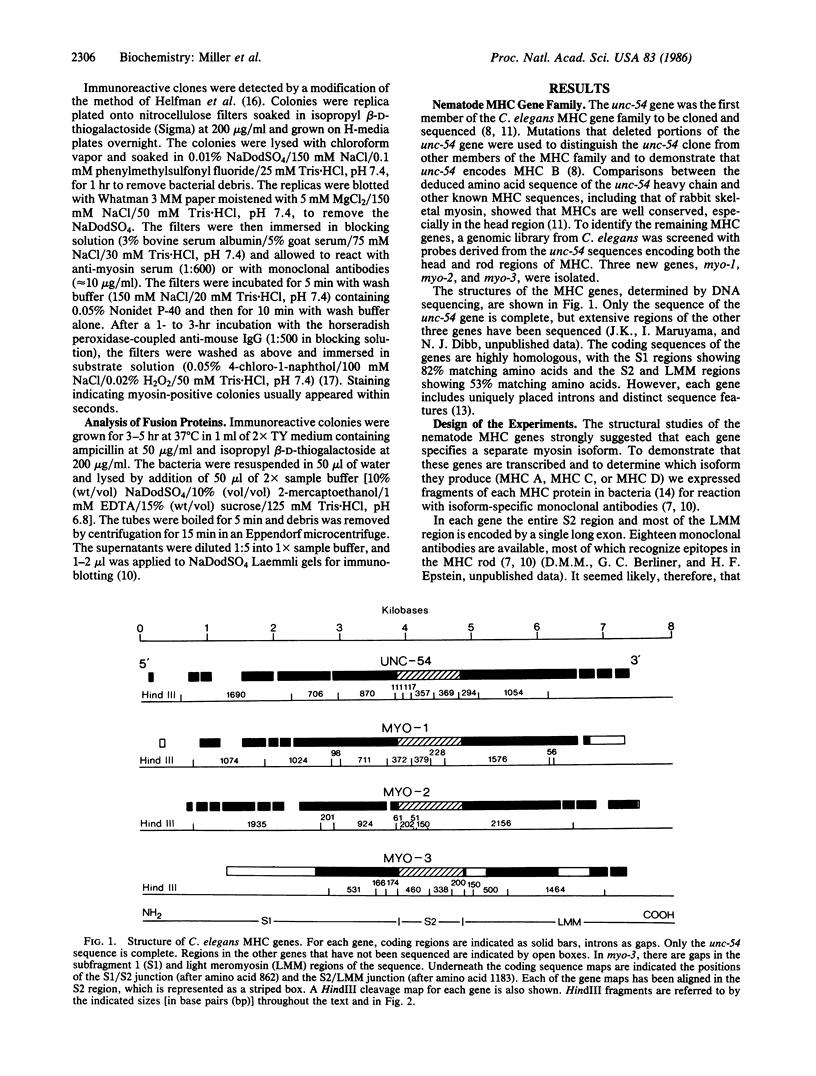
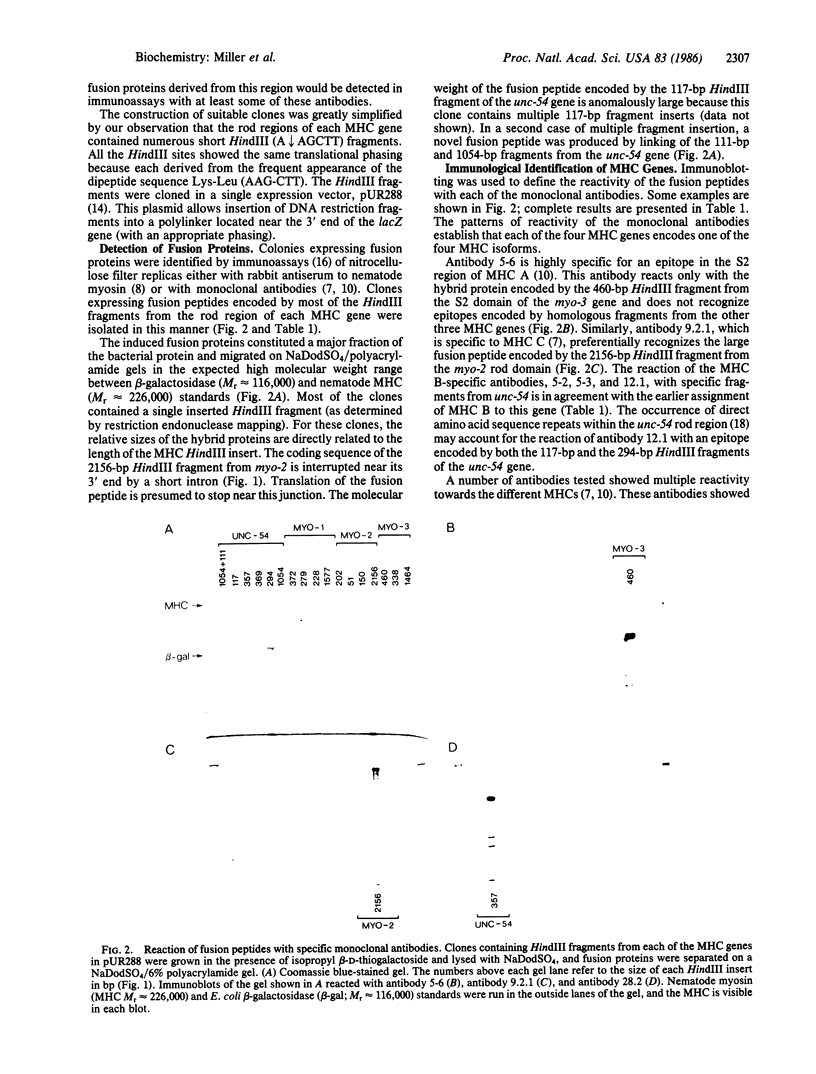
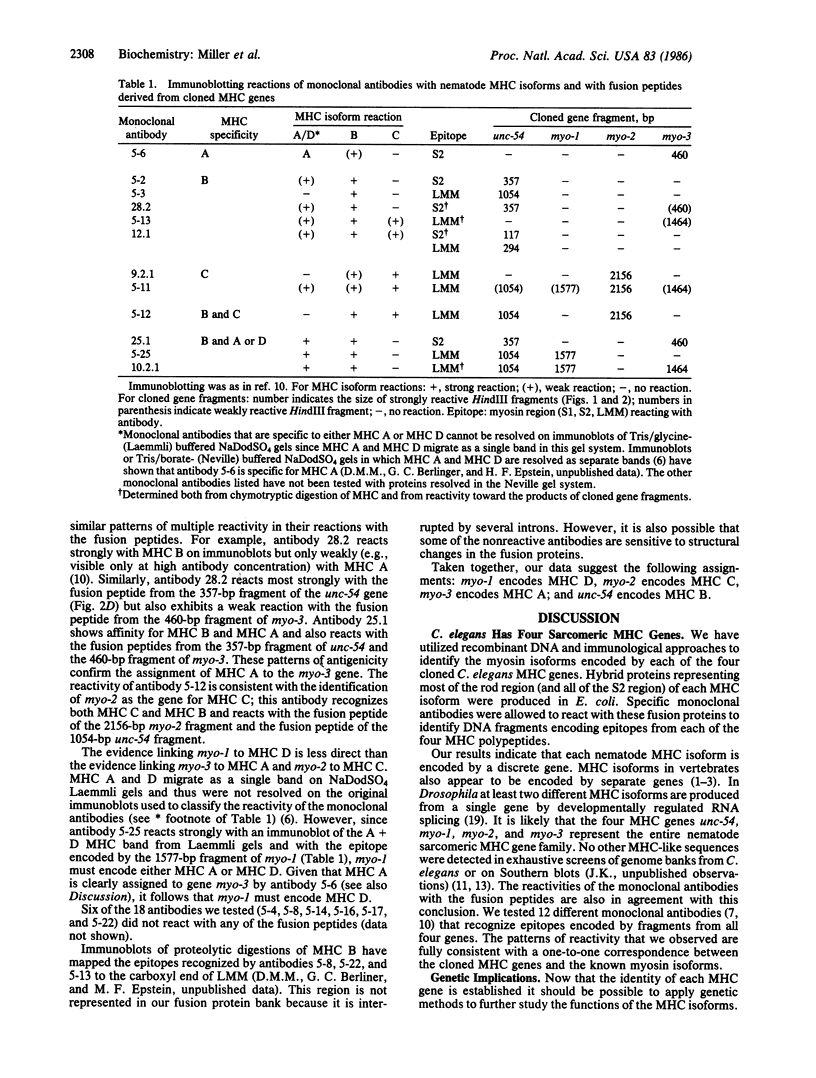
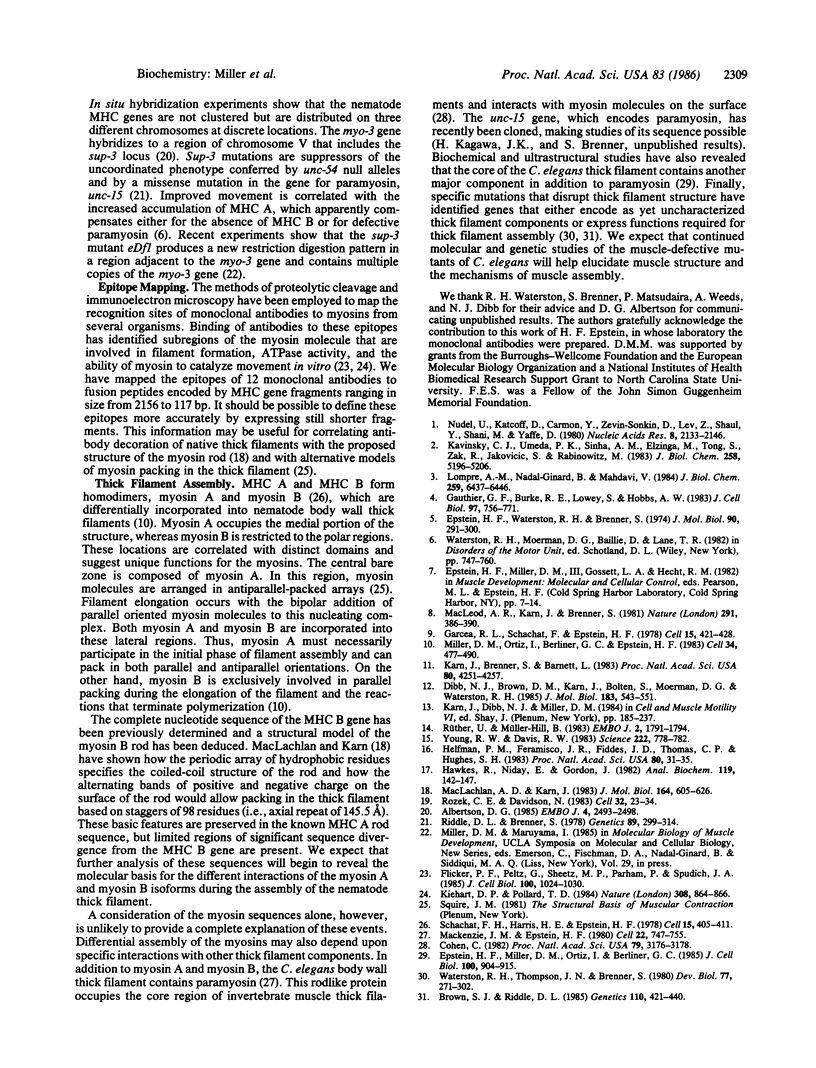
Images in this article
Selected References
These references are in PubMed. This may not be the complete list of references from this article.
- Albertson D. G. Mapping muscle protein genes by in situ hybridization using biotin-labeled probes. EMBO J. 1985 Oct;4(10):2493–2498. doi: 10.1002/j.1460-2075.1985.tb03961.x. [DOI] [PMC free article] [PubMed] [Google Scholar]
- Brown S. J., Riddle D. L. Gene interactions affecting muscle organization in Caenorhabditis elegans. Genetics. 1985 Jul;110(3):421–440. doi: 10.1093/genetics/110.3.421. [DOI] [PMC free article] [PubMed] [Google Scholar]
- Cohen C. Matching molecules in the catch mechanism. Proc Natl Acad Sci U S A. 1982 May;79(10):3176–3178. doi: 10.1073/pnas.79.10.3176. [DOI] [PMC free article] [PubMed] [Google Scholar]
- Dibb N. J., Brown D. M., Karn J., Moerman D. G., Bolten S. L., Waterston R. H. Sequence analysis of mutations that affect the synthesis, assembly and enzymatic activity of the unc-54 myosin heavy chain of Caenorhabditis elegans. J Mol Biol. 1985 Jun 25;183(4):543–551. doi: 10.1016/0022-2836(85)90170-6. [DOI] [PubMed] [Google Scholar]
- Epstein H. F., Miller D. M., 3rd, Ortiz I., Berliner G. C. Myosin and paramyosin are organized about a newly identified core structure. J Cell Biol. 1985 Mar;100(3):904–915. doi: 10.1083/jcb.100.3.904. [DOI] [PMC free article] [PubMed] [Google Scholar]
- Epstein H. F., Waterston R. H., Brenner S. A mutant affecting the heavy chain of myosin in Caenorhabditis elegans. J Mol Biol. 1974 Dec 5;90(2):291–300. doi: 10.1016/0022-2836(74)90374-x. [DOI] [PubMed] [Google Scholar]
- Flicker P. F., Peltz G., Sheetz M. P., Parham P., Spudich J. A. Site-specific inhibition of myosin-mediated motility in vitro by monoclonal antibodies. J Cell Biol. 1985 Apr;100(4):1024–1030. doi: 10.1083/jcb.100.4.1024. [DOI] [PMC free article] [PubMed] [Google Scholar]
- Garcea R. L., Schachat F., Epstein H. F. Coordinate synthesis of two myosins in wild-type and mutant nematode muscle during larval development. Cell. 1978 Oct;15(2):421–428. doi: 10.1016/0092-8674(78)90011-9. [DOI] [PubMed] [Google Scholar]
- Gauthier G. F., Burke R. E., Lowey S., Hobbs A. W. Myosin isozymes in normal and cross-reinnervated cat skeletal muscle fibers. J Cell Biol. 1983 Sep;97(3):756–771. doi: 10.1083/jcb.97.3.756. [DOI] [PMC free article] [PubMed] [Google Scholar]
- Hawkes R., Niday E., Gordon J. A dot-immunobinding assay for monoclonal and other antibodies. Anal Biochem. 1982 Jan 1;119(1):142–147. doi: 10.1016/0003-2697(82)90677-7. [DOI] [PubMed] [Google Scholar]
- Helfman D. M., Feramisco J. R., Fiddes J. C., Thomas G. P., Hughes S. H. Identification of clones that encode chicken tropomyosin by direct immunological screening of a cDNA expression library. Proc Natl Acad Sci U S A. 1983 Jan;80(1):31–35. doi: 10.1073/pnas.80.1.31. [DOI] [PMC free article] [PubMed] [Google Scholar]
- Karn J., Brenner S., Barnett L. Protein structural domains in the Caenorhabditis elegans unc-54 myosin heavy chain gene are not separated by introns. Proc Natl Acad Sci U S A. 1983 Jul;80(14):4253–4257. doi: 10.1073/pnas.80.14.4253. [DOI] [PMC free article] [PubMed] [Google Scholar]
- Lompré A. M., Nadal-Ginard B., Mahdavi V. Expression of the cardiac ventricular alpha- and beta-myosin heavy chain genes is developmentally and hormonally regulated. J Biol Chem. 1984 May 25;259(10):6437–6446. [PubMed] [Google Scholar]
- MacLeod A. R., Karn J., Brenner S. Molecular analysis of the unc-54 myosin heavy-chain gene of Caenorhabditis elegans. Nature. 1981 Jun 4;291(5814):386–390. doi: 10.1038/291386a0. [DOI] [PubMed] [Google Scholar]
- Mackenzie J. M., Jr, Epstein H. F. Paramyosin is necessary for determination of nematode thick filament length in vivo. Cell. 1980 Dec;22(3):747–755. doi: 10.1016/0092-8674(80)90551-6. [DOI] [PubMed] [Google Scholar]
- McLachlan A. D., Karn J. Periodic features in the amino acid sequence of nematode myosin rod. J Mol Biol. 1983 Mar 15;164(4):605–626. doi: 10.1016/0022-2836(83)90053-0. [DOI] [PubMed] [Google Scholar]
- Miller D. M., 3rd, Ortiz I., Berliner G. C., Epstein H. F. Differential localization of two myosins within nematode thick filaments. Cell. 1983 Sep;34(2):477–490. doi: 10.1016/0092-8674(83)90381-1. [DOI] [PubMed] [Google Scholar]
- Nudel U., Katcoff D., Carmon Y., Zevin-Sonkin D., Levi Z., Shaul Y., Shani M., Yaffe D. Identification of recombinant phages containing sequences from different rat myosin heavy chain genes. Nucleic Acids Res. 1980 May 24;8(10):2133–2146. doi: 10.1093/nar/8.10.2133. [DOI] [PMC free article] [PubMed] [Google Scholar]
- Riddle D. L., Brenner S. Indirect suppression in Caenorhabditis elegans. Genetics. 1978 Jun;89(2):299–314. doi: 10.1093/genetics/89.2.299. [DOI] [PMC free article] [PubMed] [Google Scholar]
- Rozek C. E., Davidson N. Drosophila has one myosin heavy-chain gene with three developmentally regulated transcripts. Cell. 1983 Jan;32(1):23–34. doi: 10.1016/0092-8674(83)90493-2. [DOI] [PubMed] [Google Scholar]
- Rüther U., Müller-Hill B. Easy identification of cDNA clones. EMBO J. 1983;2(10):1791–1794. doi: 10.1002/j.1460-2075.1983.tb01659.x. [DOI] [PMC free article] [PubMed] [Google Scholar]
- Schachat F., Garcea R. L., Epstein H. F. Myosins exist as homodimers of heavy chains: demonstration with specific antibody purified by nematode mutant myosin affinity chromatography. Cell. 1978 Oct;15(2):405–411. doi: 10.1016/0092-8674(78)90009-0. [DOI] [PubMed] [Google Scholar]
- Umeda P. K., Kavinsky C. J., Sinha A. M., Hsu H. J., Jakovcic S., Rabinowitz M. Cloned mRNA sequences for two types of embryonic myosin heavy chains from chick skeletal muscle. II. Expression during development using S1 nuclease mapping. J Biol Chem. 1983 Apr 25;258(8):5206–5214. [PubMed] [Google Scholar]
- Waterston R. H., Thomson J. N., Brenner S. Mutants with altered muscle structure of Caenorhabditis elegans. Dev Biol. 1980 Jun 15;77(2):271–302. doi: 10.1016/0012-1606(80)90475-3. [DOI] [PubMed] [Google Scholar]
- Young R. A., Davis R. W. Yeast RNA polymerase II genes: isolation with antibody probes. Science. 1983 Nov 18;222(4625):778–782. doi: 10.1126/science.6356359. [DOI] [PubMed] [Google Scholar]






